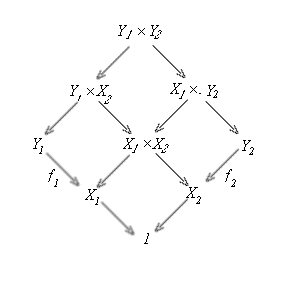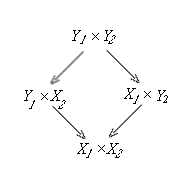Definition 1.4.1. (a) A map f:
Y --> X is called precoflat
if the pullback of any epi to X along f is epic.
(b) A map f: Y --> X is called coflat
if the pullback of f along any map to X is precoflat.
Equivalently, a map f: Y --> X is coflat if the pullback functor A/X --> A/Y along f preserves epis.
Proposition 1.4.2. (a) Coflat
maps are stable, i.e. the pullback of a coflat map is coflat.
(b) Composite of coflat maps are coflat.
(c) Finite products of coflat maps are coflat.
(d) A finite sum of maps is coflat iff each factor is coflat.
Proof. (a) and (b) are immediate.
(c) Let f1: Y1 --> X1
and f2: Y2 --> X2 be two
coflat maps. Consider the following pullback:


(d) Consider two maps u1: X1 --> T1 and u2: X2 --> T2 . If u1 + u2 is coflat, then u1 and u2 are coflat by (a) because they are pullbacks of u1 + u2 by (1.3.4.b). Conversely assume u1 and u2 are coflat. Any map from g to T1 + T2 has the form g = v1 + v2: Y1 + Y2 --> T1 + T2 for two maps v1: Y1 --> T1 and v2: Y2 --> T2. Then by (1.3.4.a) the pullback s of g along u1 + u2 is the sum of X1
Proposition 1.4.3. (a) Suppose f:
Y --> X is a mono and g: Z --> Y is a map. Then g
is coflat if fg is coflat.
(b) For any object X, the codiagonal map ![]() X:
X + X --> X is coflat.
X:
X + X --> X is coflat.
(c) Suppose {fi: Yi --> X} is a
finite family of coflat maps. Then f = ![]() (fi): Y =
(fi): Y = ![]() Yi --> X is coflat.
Yi --> X is coflat.
Proof. (a) If fg is coflat then g is coflat as
it is the pullback of fg along f.
(b) The pullback of ![]() X:
X + X --> X along a map Z --> X is the map
X:
X + X --> X along a map Z --> X is the map ![]() Z:
Z + Z --> Z . Therefore in order to show that
Z:
Z + Z --> Z . Therefore in order to show that ![]() X
is coflat it suffices to prove that
X
is coflat it suffices to prove that ![]() X
is precoflat. Assume f: Y --> X is an epi. Then the pullback
of f along
X
is precoflat. Assume f: Y --> X is an epi. Then the pullback
of f along ![]() X
is f + f: Y + Y --> X + X, which is an epi by (1.3.7).
X
is f + f: Y + Y --> X + X, which is an epi by (1.3.7).
(c) For any pair of coflat maps f: Y --> X and g:
Z --> X the induced map (f, g): Y + Z --> X is
the composite of the coflat maps f + g: Y + Z --> X + X and ![]() X:
X + X --> X by (b) and (1.4.2.d). Thus (f,
g) is coflat. This result extends immediately to a map of the form
f =
X:
X + X --> X by (b) and (1.4.2.d). Thus (f,
g) is coflat. This result extends immediately to a map of the form
f = ![]() (fi):
Y =
(fi):
Y = ![]() Yi --> X.
Yi --> X.
Recall that a map in a category is a bimorphism if it is both epic and monic.
Proposition 1.4.4. (a) Coflat monos
are stable.
{b} Composites of coflat monos (bimorphisms) are coflat monos (bimorphisms).
(c) Finite intersections of coflat monos (bimorphisms) are coflat mono
(bimorphisms).
(d) A finite sum of monos (bimorphisms) is a coflat mono (bimorphisms)
iff each factor is a coflat mono (bimorphisms).
(e) Suppose f: Y --> X is a coflat bimorphisms. If g:
Z --> Y is a map such that fg is an epi, then g is an
epi.
(f) Suppose f: Y --> X is a coflat mono (bimorphisms)
and g: Z --> Y is any map. Then g is a coflat mono
(bimorphisms) iff fg is a coflat mono (bimorphisms).
Proof. (a) - (d) follows from (1.4.2), (1.3.7)
and (1.3.8).
(e) Since f is a mono and fg factors through f,
(g, 1Z) is the pullback of (f, fg).
If fg is an epi then g is an epi as f is coflat by
assumption.
(f) follows from (e) and (1.4.3.a).
Proposition 1.4.5. Injections of a sum are coflat monos.
Proof. The injection X --> X + Y is the sum of the coflat
mono 1X: X --> X and the coflat mono 0 -->
Y . Thus by (1.4.4.d) it is coflat.